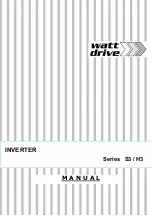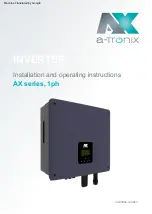
Page 12
POWERING DIRECT / EMBEDDED SWITCHED MODE
POWER SUPPLY (SMPS)
Non-linear nature of current drawn by Switched Mode Power Supplies
Power supplies are used to convert AC voltages like 120 VAC to various DC voltages
like 3.3 V, 5 V, 12 V, 24 V, 48 V etc. Majority of modern day electronic devices use
embedded general purpose
S
witch
M
ode type of
P
ower
S
upplies (SMPS) to drive the
electronic circuitry. General purpose
S
witch
M
ode
P
ower
S
upplies (SMPS) (
excepting
those that have power factor correction
) have one major disadvantage – the current
drawn by them from the AC power source has a
non linear waveform
( the waveform
is not sinusoidal as the input voltage waveform but is in the form of short, larger
value pulses around the area of + Vpeak and -Vpeak ). This is due to the charging of
the input filter capacitor(s) mostly around the positive and negative peak portions of
the sinusoidal input voltage. The degree of non-linearity is measured by the "
Crest
Factor
":
Crest Factor = Peak Current / RMS Current
In a linear load, the Crest Factor is 1.414. However, in a general purpose SMPS, due to
its non linear nature, this factor will be much higher - in the region of up to 4. This will
mean that for a particular rated RMS current (applicable for a linear load), the general
purpose SMPS will draw much larger peak currents – approx. up to 4 times more than
its rated RMS current.
Inverters are protected against over current ( also called overloading ) by either
clipping the peaks of the output voltage (
this will result in a sine wave becoming
a square wave, reduction in the RMS value of the output voltage and generation
of harmonics and electrical noise ) or by shutting down the output voltage of the
inverter completely. Thus, if an inverter / generator is used to power a general
purpose SMPS, it will be forced to deliver higher peak currents resulting in premature
triggering of the inverter’s / generator's over current protection circuits. Thus, for safe
operation, the continuous RMS current rating of the inverter / generator should be at
least 2.8 times the continuous RMS current rating of the general purpose SMPS it is
required to power:
Peak current of inverter = Peak current of SMPS
or
RMS current of inverter X 1.414 = RMS current of SMPS X 4
or
RMS current of inverter = 4/1.414 X RMS current of SMPS
or
RMS current of inverter = 2.8 X RMS current of SMPS)
Alternatively, the continuous power rating of the inverter / generator in Watts / VA
should be at least 2.8 times the continuous power rating of the SMPS in Watts / VA














































